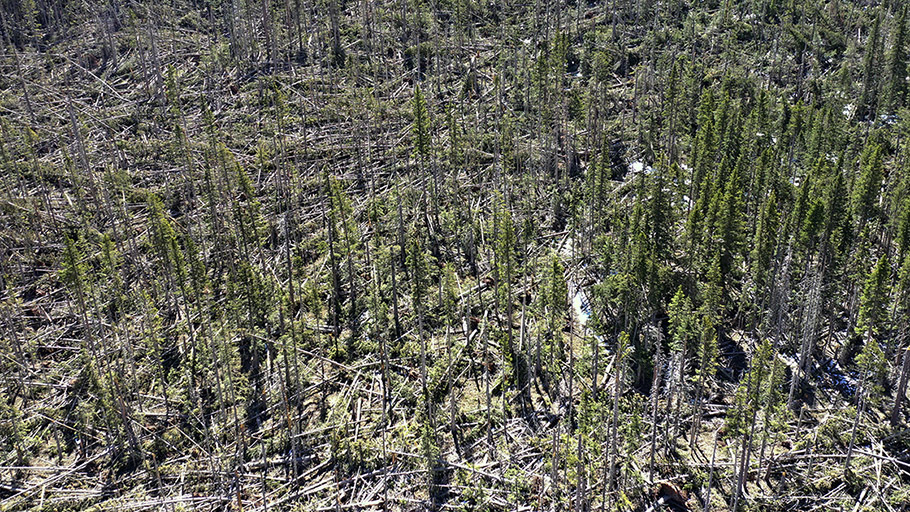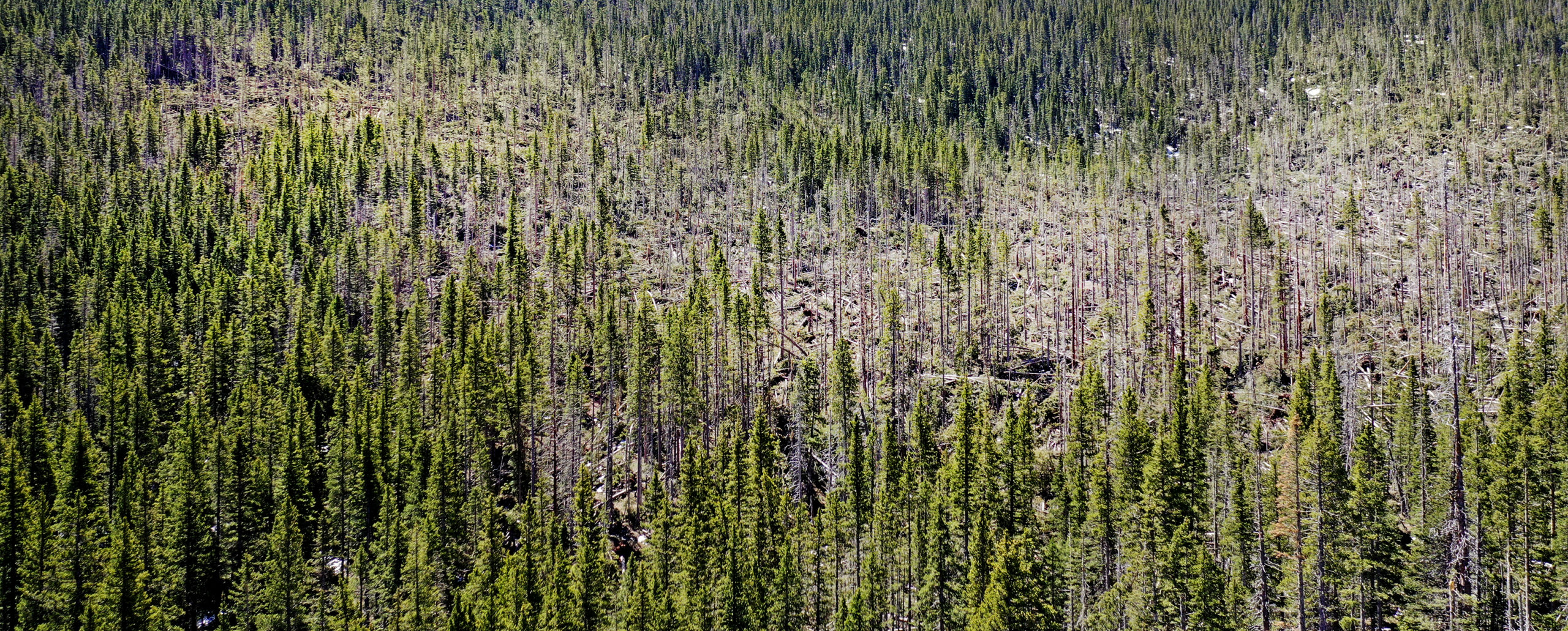
Strong winds fell hundreds of trees, closing trails, roads, campsites
by Mark Craddock
OUR WORLD — The winds came early and hard to South-Central Colorado this year.
Late autumn squalls in 2021, followed by bursts of unseasonably strong spring gusts wreaked havoc on roofs and fences, power lines and trees in communities throughout our region.
But the situation is even worse in the backcountry, where the winds have felled hundreds of tall spruce weakened by years of drought and disease, leaving acres of deadfall timber clogging trails and campgrounds, and the danger that more trees will fall.

Worst hit locally has been the Bear Lake and Blue Lake areas in the San Isabel National Forest, where downed trees have left many roads, trails and campgrounds inaccessible and closed till further notice.
On June 1, the San Carlos Ranger District ordered the Bear Lake and Blue Lake campgrounds near Cuchara, as well as nearby roads and a broad swath of adjacent land, closed until May 1, 2023 because of downed timber and the threat that more trees will fall.
“Hundreds of spruce trees in and around the campgrounds have blown down and the remaining standing trees are now more susceptible to wind damage,” said District Ranger Steven Sanchez. “The risk of trees falling while people are camping, parking or recreating in the developed campground sites is very high.”
“The described area,” the USFS order reads, “includes the Bear Lake and Blue Lake Campgrounds within the San Carlos Ranger District, San Isabel National Forest… and all NFS roads bordering and within the described area.”
“The purpose of this order is to protect public safety by prohibiting entry into the campgrounds, surrounding area, and associated roads due to severe blowdown and continuing danger of further downfall.”
The order prohibits “going into or being upon” the described area or roads, except people with a special-use authorization or other Forest Service authorization, or members of an organized rescue group or firefighting force in the performance of an official duty.
The closure encompasses land from the Indian Creek/Bear Lake Trailhead to the north, to the Blue Lake Campground to the south, east of Forest Service Road 422.
Blue Lake itself remains open for fishing.
The road closure extends south of Blue Lake Campground, encompassing Forest Service Roads 422.A, 436.C, 436.B to the North Fork Trailhead, and further west on 436 and 436.A along the Huerfano and Las Animas county border.
According to federal law, violating the closure order is punishable by a fine of not more than $5,000 for an individual or $10,000 for an organization, and/or imprisonment for up to six months.
The Forest Service is actively assessing and evaluating the situation, Sanchez said, identifying options to remove the downed timber and remaining hazard trees, and repairing damage to the campgrounds.
All existing reservations have been cancelled and refunds issued. To make alternate plans, the USFS encourages people to visit their website at https://www.fs.usda.gov/recmain/psicc/recreation. For questions about this closure, please contact the San Carlos Ranger District office at 719-269-8500.
Blame it on wind and drought
Up and down the Interstate-25 corridor, December 2021 winds flipped trucks and high-profile vehicles, brought down power lines and trees, turned roof shingles into confetti and, in Boulder County, precipitated the most damaging wildfire in Colorado history.
Locally, wind gusts between 50 and 60 miles per hour were commonplace that month.
There was very little reprieve from steady winds throughout the winter of 2022, with extreme gusts returning to the region in March and April.
National Weather Service Meterologist Makoto Moore said our corner of the world is in the waning throes of a La Niña weather pattern, in which cool water temperatures in South Pacific force the normal jet stream north, depriving the plains of the typical northwestern storm systems that would blanket the region in snow.
“We are fully in the La Niña pattern,” he said in January. “We’ll keep our fingers crossed for good mountain snow to set up the snowpack, but down here on the plains it usually means extending drought conditions.”
And it means wind. Lots of it.
South Central Colorado is also experiencing an ongoing drought, which has deprived trees of water and made them more susceptible to disease and insect infestation.
All of Huerfano County and most of western Las Animas County remained in severe drought conditions through the end of 2001, according to the U.S. Drought Monitor. Central and eastern Las Animas County was listed as experiencing moderate drought conditions, while pockets of the far-eastern reaches of the county are seeing extreme and exceptional drought conditions.
Colfax County, New Mexico, is also experiencing regions of severe and extreme drought, according to the U.S. Drought Monitor.
The U.S Drought Monitor’s June 9, 2022 map showed most of Our World hovering between moderate and severe drought conditions. But for the backwoods, the damage has already been done.
Damage widespread, tourism may suffer
Bob Kennemer, who is involved in several local tourism efforts and is himself an avid hiker, said the situation is bleak and damage is far more widespread than just the Bear Lake and Blue Lake areas.
He said that on a recent hike along the North Fork Trail just past North Lake and the Purgatory Campgrounds, he found the trail riddled with fallen aspen and deciduous trees, as well as pine and spruce.
“You can’t go over it or around it,” he said. “There are literally mountains and piles of trees. There is no way hunters will be able to haul any game out of there. The trail is also designed for horseback riding. But there’s no way a horse or human can go up there.”
He said he doesn’t think the general public and local businesses are aware of jut how pervasive the damage is.
“We lost the Indian Trail up Sulfur Springs due to the fire (the 2018 Spring Fire),” and the subsequent flooding, he said. “Now Bear and Blue Lake and the North Creek Trail. Almost all the trails in the San Carlos Ranger District in San Isabel National Forest are completely or partially damaged.”
“Most of the public land is now inaccessible,” Kennemer said. “That will have an impact on recreational tourism.”r.




